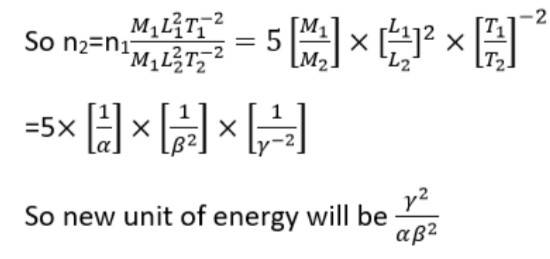Units and Measurements
Get insights from 91 questions on Units and Measurements, answered by students, alumni, and experts. You may also ask and answer any question you like about Units and Measurements
Follow Ask QuestionQuestions
Discussions
Active Users
Followers
New answer posted
4 months agoContributor-Level 10
This is a long answer type question as classified in NCERT Exemplar
Dimensions of energy is E= [ML2T-2]
Mass m= [M]
Dimension of E= [ML2T-2]
Dimensions of L= [ML-2T-1]
Dimensions of G= [M-1L3T-2]
By using these values [P]= [ML2T-2] 2 -2
= [M1+2-5+2L2+4-6T-2-2+4]
= [M0L0T0]
After we know that P is dimensionless quantity
New answer posted
4 months agoContributor-Level 10
This is a long answer type question as classified in NCERT Exemplar
As we know that X= a2 b3 c5/2 d-2
Maximum percentage error in X is
=
Mean absolute error in X= rounding off to significant value.
And calculated value would be 2.8 rounding off upto two digits.
New answer posted
4 months agoContributor-Level 10
This is a long answer type question as classified in NCERT Exemplar
Rate of flow is equal to V=
Dimensions of V or LHS= volume/time=L3/T= [L3T-1]
Dimensions of P= [ML-1T-2]
Dimensions of = [ML-1T-1]
Dimensions of L= [L]
Dimensions of r= [L]
Dimensions of RHS=
So they are in equal in dimensions.
So equation is correct dimensionally.
New answer posted
4 months agoContributor-Level 10
This is a long answer type question as classified in NCERT Exemplar
Energy E= [ML2T-2]
Let M1, L1 and T1 and M2, L2 and T2 are fundamental quantities for two units
M1=1kg and L1=1m and T1=1s
M2= α kg, L2= β m and T2= γ s
And n1u1=n2u2

New answer posted
6 months agoContributor-Level 10
2.32
Distance of the moon from Earth = 3.84 * 108 m
Distance of the Sun from Earth = 1.496 * 1011 m
Sun's diameter = 1.39 * 109 m
Sun's angular diameter = 1920° = 1920 * 4.85 * 10-6 rad = 9.3 * 10-3 rad
During total Solar eclipse, the moon completely covers the Sun, then the angular diameter of both Sun and the
Moon will be equal
So the angular diameter of moonΘ = 9.3 * 10-3 rad, distance d of moon from Earth = 3.84 * 108 m and
diameter of the moon = angular diameter * distance
So the approximate diameter of the Moon = 9.3 * 10-3 * 3.84 * 108 m = 35.712 * 105 m
New answer posted
6 months agoContributor-Level 10
2.31
Speed of light = 3 * 108 m/s, Time taken = 3 billion years = 3 * 109 years = 3 * 365 * 24 * 60 * 60 * 109 s
The distance = speed x time = 3 * 108 * 3 * 365 * 24 * 60 * 60 * 109 m
= 2.838 * 1025 m
New answer posted
6 months agoContributor-Level 10
2.30
Speed of the sound in water = 1450 m s–1
Time taken from generation + reflection = 2t = 77 s
From the relation s = ut, where s is the distance of the enemy ship, we get
s = 1450 * 77/2 m = 55825 m = 55.8 km
New answer posted
6 months agoContributor-Level 10
2.29 Time taken by the laser beam after reflection = 2.56 s
The speed of laser = 3 * 108 m/s
If the distance between Earth and the Moon is d, the distance covered by laser beam is 2d
From the relation distance = speed * time, we get
d = (2.56 * 3 * 108)/2 = 3.84 * 108 m
New answer posted
6 months agoContributor-Level 10
2.27
The diameter of the sodium atom = 2.5 Å = 2.5 * 10-10 m
Radius of the sodium atom = 1.25 * 10-10 m
Volume of the sodium atom = (4/3)(π) r3 = (4/3) * (22/7) * (1.25 * 10-10) m3 = 8.18 * 10-30
Mass of 1 mole atom of sodium = 23 g = 23 * 10-3 kg
1 mole of sodium contains 6.023 * 1023 atoms.
Hence mass of 1 sodium atom = (23 * 10-3)/ (6.023 * 1023) = 3.818 * 10-26 kg
Atomic mass density of sodium = M/V = (3.818 * 10-26)/ (8.18 * 10-30) kg/m3 = 4667.48 kg/m3
The density of sodium in its solid state is 4667.48 kg/m3 but in the crystalline phase is 970 kg/m3.
In crystalline phase there are voids in between atoms, hence the density
Taking an Exam? Selecting a College?
Get authentic answers from experts, students and alumni that you won't find anywhere else
Sign Up on ShikshaOn Shiksha, get access to
- 65k Colleges
- 1.2k Exams
- 679k Reviews
- 1800k Answers
